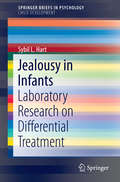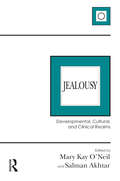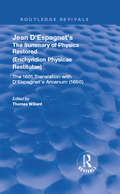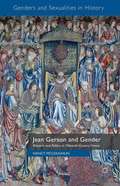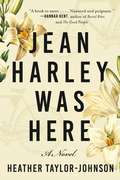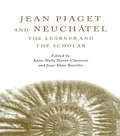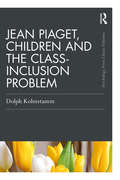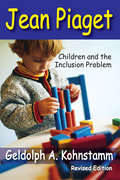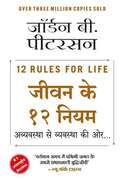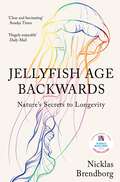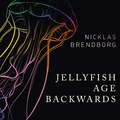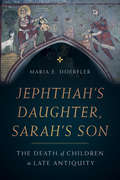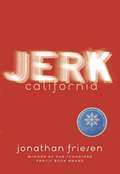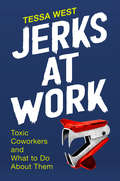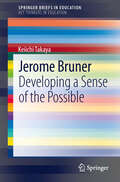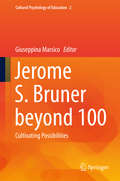- Table View
- List View
Jealousy in Infants
by Sybil L. HartThis Brief synthesizes findings from recent experiments on jealousy in infants with insights from pioneering thinkers in developmental science. It discusses attachment issues, status of jealousy as an emotion and as a feature of temperament, underpinnings in social cognition, the development of adaptive versus maladaptive presentations, and facets of jealousy that may be part of a normal repertoire of coping strategies. This unique volume also identifies facial, vocal, and bodily responses associated with jealousy as well as situations of differential treatment by caregivers that may bring them about. This knowledge is as useful in studying children's emotional development as it is in addressing jealousy-based challenges in growing families. Among the featured topics: Jealousy in infants, defended and defined. A theory of jealousy as temperament. Sadness, anger, fear, and love. Individual differences and normativity. Child and contextual influences on individual differences. Implications for clinical intervention: preparing for a sibling's arrival. Jealousy in Infants is an essential resource for researchers, clinicians, and graduate students in developmental psychology, infant mental health, and social psychology.
Jealousy, Femininity and Desire: A Lacanian Reading (The Palgrave Lacan Series)
by Dana Tor-ZilbersteinDrawing on Freudian and Lacanian psychoanalysis, this book intervenes into debates concerning the relation between jealousy and envy on the one hand, and sexual difference on the other. The author presents an original distinction between what is termed “feminine” and “phallic” forms of jealousy while mapping and theorizing other types of jealousy that she finds in the writings of Sigmund Freud and Jacques Lacan. The discussion performs literary-critical readings of texts by Olivia Shakespear and Marguerite Duras as a means of shedding light on the topic and the distinction. Further, it discusses the challenge posed by jealousy’s particular mode of jouissance and its possible vicissitudes. Though the experience of jealousy can be ravaging, the author claims, it also provides the subject an opportunity to reorient its relation to jouissance and thereby experience significant psychical change. In doing so, it provides a new outlook on jealousy as being connected to both femininity and desire, unveiling its complex character, features, and vitality within a Lacanian psychoanalytic framework. It will appeal in particular to those with an interest in psychoanalysis, literary theory and critical theory.
Jealousy: Developmental, Cultural, and Clinical Realms
by Salman Akhtar Mary Kay O’NeilJealousy is a human feeling experienced by everyone in varying intensities, at different times and phases of growth. Frequently confused, jealousy and envy are often intertwined. Even within the psychoanalytic literature confusion persists and much less has been written about jealousy than envy. However, unlike envy, jealousy involves three entities and affects all people involved. It can be painful as other difficult-to-bear feelings (e.g. shame, guilt anger, hatred) underlie jealousy. Yet, total absence of jealousy renders a person less human, less relational. In analytic terms jealousy is a defense against emotional anguish. This book begins with an extensive overview of the nature, developmental origins and poignant cultural (especially poetic) allusions to jealousy, emphasizing that it is through artistic expression that a true understanding of this frequently deeply disturbing feeling is achieved. It closes with a thoughtful summary, synthesis and critique of the chapters by 12 distinguished analysts.
Jean Améry: Beyond the Mind's Limits
by Yochai Ataria Amit Kravitz Eli PitcovskiThis volume explores themes originating from the work of Jean Améry (1912–1978), a Holocaust survivor and essayist—mainly, ethics and the past, torture and its implications, death and suicide. The volume is interdisciplinary, bringing together contributions from philosophy, psychology, law, and literary studies to illuminate each of the topics from more than one angle. Each essay is a novel contribution, shedding new light on the relevant subject matter and on Jean Améry's unique perspective. The ensuing picture is rich and multifaceted, uncovering unforeseen traits of Amery's thought, and surprising correlations that have so far been under-researched. It invites further studies of the Holocaust and its consequences to take their cue from non-neutral first person reflections.
Jean D'Espagnet's The Summary of Physics Restored: The 1651 Translation With D'espagnet's Arcanum (1650) (Routledge Revivals #7)
by Jean D'EspagnetPublished in 1999: This book is about Alchemy, Philosophy and Science during the 17th century written by the author originally published in 1650.
Jean Gerson and Gender
by Nancy McloughlinJean Gerson and Gender reconciles the somewhat enigmatic legacy of one of the most influential late medieval intellectuals: the theologian, court preacher, university chancellor, and church reformer, Jean Gerson (d. 1429). Gerson provided foundational contributions to two historical developments: the promotion of rational and just government, and the development of the European concept of the witch. This book argues that Gerson's association of royal and ascetic women with sin and diabolical influences allowed him to maintain - against overwhelming evidence to the contrary – the appearance of centralized monarchical rule, a stable ecclesiastical hierarchy, and a reliable method for constructing communally verifiable political and religious truths.
Jean Harley Was Here: A Novel
by Heather Taylor JohnsonFinalist for the Readings Prize for New Australian FictionFor readers of Everything I Never Told You and When I’m Gone, a profoundly moving, heartwarming debut about family, relationships, and what we leave behind. Jean Harley-wife, mother, lover, dancer-is a shining light in the lives of those who know and love her, full of boundless energy, compassion, and joy. When she's hit by a truck while riding her bicycle and the unthinkable happens, what becomes of the people she leaves behind? Her devoted husband, Stan, is now a single father to their four-year-old son, Orion, who doesn't understand why his mom won't come home. Jean's two best friends, Neddy and Viv, find their relationship unraveling without their third companion. Charley, the ex-con who caused the accident, struggles to reconcile his feelings of elation when the charges against him are dropped with his boundless guilt over knowing he has changed a family forever; while Jean's mother, Pearl, will regret the little girl who left. Gradually, life without Jean goes on, yet her indelible spirit remains.Told from the alternating perspectives of these and other characters who grieve the same death in vastly different ways, Jean Harley Was Here is a moving, poetic novel about loss, memory, and the lives we touch.
Jean Piaget and Neuchâtel: The Learner and the Scholar
by Anne-Nelly Perret-Clermont Jean-Marc BarreletJean Piaget is widely acknowledged as one of the most important scholars of the twentieth century. His passionate philosophical search for an understanding of the nature of knowledge led him to make major contributions to the study of child development and epistemology. But how did his early life in Neuchâtel inspire him to embark on this search? Taking a socio-historical and cultural perspective, this book outlines the development of Piaget's understanding of major issues regarding mind, faith, science, logic, peace, and social rights in a time of anxiety. and world wars The international and multidisciplinary contributors investigate Piaget the adolescent as he begins his quest for autonomy of reason and sets out to create his own explanatory system for cognitive growth. The latter part of the book goes on to consider the early reception of Piaget's work in different cultural contexts and his impact on issues of psychology and educational reform. Piaget's theoretical system can be seen as an expression of the values he developed during his childhood and adolescence as he searched for the conditions of reciprocal relationships and rational dialogues. Jean Piaget and Neuchâtel demonstrates that in today's climate, the questions Piaget addressed remain very relevant and invite new enquiries from different standpoints. This book will therefore be of interest to psychologists, educators, and philosophers. This book is published with the support of Pro Helvetia, Swiss Arts Council.
Jean Piaget, Children and the Class-Inclusion Problem (Psychology Press & Routledge Classic Editions)
by Dolph KohnstammThe Classic Edition of Dolph Kohnstamm’s Jean Piaget, Children and the Class-Inclusion Problem, first published in 1967, includes a new introduction by the author, describing for readers the original context for his work, how the field has moved forward and the ongoing relevance of this volume. This enduring text offers a critical study of a cornerstone of Piaget’s theory that a child's ability to solve problems of class-inclusion marks the beginning of the period of concrete (logical) operations at about 7 or 8 years of age. Kohnstamm's experiments show, however, that, with a teaching method that provokes children’s authentic logical thinking processes, most children of 5 can already learn to solve a variety of class-inclusion problems, up to a level where they can even invent similar but new problems themselves. These results question the basic assumption of Piaget's theory that logical operations can only develop in firmly connected groupings of operations. Kohnstamm argues that experimenters must, therefore, show that children who come to master one kind of operation should also show transference to other operations of the same grouping. This insightful volume questions the real existence in brain functioning of Piaget’s families of logical operations. No experimental proof of such families has ever been demonstrated, and thus is solely an assumption in Piaget’s theory. This challenge to Piaget's theory is an invaluable resource for students and scholars of cognitive, developmental and educational psychology.
Jean Piaget: Children and the Inclusion Problem (Revised Edition)
by Robert PerrucciJean Piaget, renowned Swiss developmental psychologist and epistemologist, is best known for his groundbreaking studies with children, which led him to develop a landmark theory of cognitive development. Geldolph A. Kohnstamm's Jean Piaget: Children and the Inclusion Problem is a critical study of a cornerstone of Piaget's theory. This theory holds that a child's ability to solve problems of class inclusion marks the beginning of the period of concrete (logical) operations at about seven or eight years of age.Kohnstamm's experiments show, however, that with directive teaching methods, most children of five can already learn to solve inclusion problems. His results make him question the basic assumption of Piaget's theory that logical operations can only develop in firmly connected groupings of operations, not in isolation. The author argues that experimenters must therefore show that children who come to master one kind of operation should also show transference to other operations of the same grouping. As a result, he questions the real existence in brain functioning of the hypothesized groupings of operations in Piaget's theory.This book is a revised edition of the 1967 original and includes a new introduction and epilogue. The original book was published in the Netherlands, not in the United States. Therefore it has reached only a negligible US audience and has sadly escaped the attention of many interested in Piaget's developmental theory. This challenge to Piaget's theory is an invaluable resource for cognitive, developmental, and educational psychologists.
Jean Piaget: Consensus And Controversy (International Library Of Psychology)
by Geoffrey Brown Sohan Modgil Celia ModgilThis book was first published in 1983.
Jean-François Lyotard: Pedagogies of Affect (SpringerBriefs in Education)
by Kirsten LockeThis book gives an introduction to Jean-François Lyotard (1924–1998) as an educational thinker whose philosophical encounters with politics and art offer a radical reconsideration of the aims of education and the nature of pedagogy. The book approaches Jean-François Lyotard’s contributions to educational thought by placing his changing intellectual career within its thematic and pedagogical context. Central chapters deal with Lyotard’s key concepts utilised throughout different phases of his intellectual career, providing new openings and perspectives to an affective form of pedagogy that questions the conditions and perimeters of the educational endeavour as a learning and teaching event. Within these discussions, Lyotard’s ideas about aesthetics and politics receive close attention. The book positions Lyotard’s pedagogical focus within key theoretical concepts traversed in his political and aesthetic writings, exploring his work on the political as an ethical activity, art as resistance, and his later work on childhood and infancy as a state of openness and receptivity.
Jeden Tag ein bisschen Erholung: Impulsgeber für mehr Urlaubsfeeling im Alltag
by Anna Rosa OttViel zu tun und kein Urlaub in Sicht? Wunderbar – dann ist jetzt genau die richtige Zeit für Erholung! Erholung ist ein wahres Wundermittel, um sich gegen Stress zu wappnen. Und auch zwischen Videokonferenzen, langen Besprechungen und Alltagsverpflichtungen findet sich Zeit für kleine Auszeiten. Dieser Ratgeber zeigt Ihnen, wie Sie Auszeiten zur richtigen Zeit nehmen. Wie Sie am Abend gut abschalten und am Wochenende so richtig auftanken. Wie Sie es anstellen, sich bei Zeitknappheit ein Stück Regeneration zu holen. Dafür brauchen Sie weder (mehr) Urlaub noch viel Zeit, sondern Lust auf Alltagsabenteuer, Schaffensrausch und neue Routinen. Die Autorin präsentiert Ihnen in diesem Buch das erforderliche Handwerkszeug, mit dem Sie die Herausforderungen Ihres Alltags gut meistern können. Rechtzeitig Kraft tanken ist der Schlüssel – ab sofort jeden Tag ein bisschen.
Jeder Job kann glücklich machen: Hol Dir die Freude an der Arbeit zurück
by Marion Lemper-PychlauGlück ist immer eine Eigenleistung. Darum birgt jeder Job trotz aller Widrigkeiten das Potenzial, erheblich zur Erfüllung und Bereicherung des eigenen Lebens beizutragen. Dazu sind Entschlossenheit und Geschick erforderlich, denn Glück braucht Know-how. Die Autorin gibt zahlreiche Hinweise und Tipps, wie jeder Beschäftigte auf seine ganz eigene Weise jeden Tag, an jedem Arbeitsplatz selbstverantwortlich freudvolle Momente entstehen lassen kann.Zugleich wendet sich die Expertin für Arbeitsfreude gegen die Konzepte der unablässigen Selbstmotivierung und Zweiteilung nach der Work-Life-Balance. Sowohl Arbeit wie Freizeit sind wertvolle Lebenszeit. Deshalb gilt es, auch das Glückspotenzial der Arbeit auszuschöpfen und die Arbeit genau wie die Freizeit mit allen Kräften zu genießen.
Jeevan ke 12 Niyam: जीवन के १२ नियम
by Jordan B. Petersonजीवन के 12 नियम अव्यवस्था से व्यवस्था की ओर... वे सबसे मूल्यवान बातें कौन सी हैं, जिनसे हर किसी को परिचित होना चाहिए? जाने-माने मनोवैज्ञानिक जॉर्डन पीटरसन ने इंसानी व्यक्तित्व के बारे में आधुनिक समझ पर गहरा प्रभाव डाला है और अब वे दुनिया के सबसे मशहूर विचारकों में से एक के तौर पर जाने जाते हैं। बाइबल से लेकर प्रेम-संबंधों और पौराणिक आख्यानों तक विविध विषयों पर उनके लेक्चर्स ने करोड़ों दर्शकों का ध्यान आकर्षित किया है। अभूतपूर्व बदलावों और धुव्रीकरण (फूट डालने) की राजनीति वाले इस दौर में व्यक्तिगत जिम्मेदारी और प्राचीन प्रज्ञा से जुड़े उनके स्पष्टतावादी और नई सोच वाले संदेशों को दुनिया भर में हाथों-हाथ लिया गया है। इस किताब में उन्होंने बारह ऐसे गहन और व्यावहारिक नियम बताए हैं,जो हमें सिखाते हैं कि एक अर्थपूर्ण जीवन कैसे जिया जाए। अपने निजी जीवन व अपने मरीजों के साथ हुए जीवंत अनुभवों से और मानवता के सबसे प्राचीनतम मिथकों और कहानियों से मिलनेवाली शिक्षाओं से प्रेरित होकर, उन्होंने जीवन के 12 नियम शीर्षक वाली इस किताब में हमारे जीवन में मौजूद अराजकता के नाशक आधुनिक समस्याओं पर लागू होने वाले शाश्वत सच को प्रस्तुत किया है।
Jefes: Aprenda a conocerlos y gane su confianza
by Xavier GuixSi aprendemos a mirar a nuestro jefe de una manera diferente seremos capaces de mejorar nuestra relación con él. ¿Qué creencias e ideas preconcebidas tenemos sobre nuestros jefes? ¿Qué consecuencias tienen estas creencias cuando tratamos con ellos? La mayor parte de esas ideas y prejuicios son negativos, y condicionan considerablemente las relaciones en las empresas. Todos hemos oído o pronunciado frases como: o En el trabajo el jefe no puede ser tu amigo.o El jefe nunca acepta que no tiene razón.o Los jefes no hacen nada, están todo el día reunidos.o Los jefes toman decisiones sin conocer realmente los problemas. Xavier Guix recoge y desarma estas y otras muchas creencias negativas acerca de los jefes, tan extendidas entre los empleados, y propone sustituirlas por nuevas actitudes, más operativas y útiles, y que ayuden a generar un cambio positivo en la relación con nuestros superiores jerárquicos. Al fin yal cabo, la manera en que nos entendamos con el jefe condicionará nuestra capacidad para progresar profesionalmente y para ampliar nuestro horizonte en el trabajo. Reseñas:«Es un libro excepcional para comprender qué creencias y miedos existen detrás de la figura de los jefes y cómo podemos construir relaciones más saludables y positivas, desde una visión innovadora, inspiradora, práctica y llena de sabiduría. Enhorabuena, Xavier.»Pilar Jericó, escritora, socia y directora general de Be-Up «"Mente clara y corazón tierno", Xavier Guix une ambos principios en este nuevo libro. Su experteza en comunicación y creencias, unida al concepto de la ecología emocional, ennoblece el mundo de las organizaciones impregnándolas de sentido. Xavier forma parte de nuestras vidas y redes de afecto, así como del proyecto que compartimos en el Instituto de Ecología Emocional.»Mercè Conangla y Jaume Soler, creadores de la ecología emocional «En los tiempos que corren es importante cambiar de forma radical los miedos y bloqueos tradicionalmente asociados a la figura del jefe. Necesitamos generar mayor fluidez comunicativa entre los que ostentan ese cargo y los que no. Xavi Guix nos descubre con su brillantez habitual algunos de los secretos para hacerlo.»Franc Ponti, director del Centro de Innovación de EADA y coautor de Inteligencia creativa «¿Te interesa tener una buena relación con tu jefe o tus colaboradores? Entonces necesitas este libro. ¡Yo lo uso como manual de cabecera!»Antonio González Barrios, socio fundador del grupo Intercom
Jellyfish Age Backwards: Nature's Secrets to Longevity
by Nicklas Brendborg"In a field characterised by overclaiming and wishful thinking, it is judicious, sensible and refreshingly clear. And fascinating." Sunday TimesA deep-dive into the astonishing nature and true science of longevity Molecular Biologist Nicklas Brendborg takes us on a journey from the farthest reaches of the globe to the most cutting-edge research to explore everything the natural world and science have to offer on the mystery of aging.From the centuries-old Greenland shark and backwards-aging jellyfish to the man who fasted for a year and the woman who successfully edited her own DNA, this book follows the thread of every experiment, story, and myth in the search for immortality.With mind-bending discoveries and physiological gifts that feel closer to magic than reality, Jellyfish Age Backwards will reshape everything you thought you knew about aging - and offer nature's secrets to unlocking your own longevity.
Jellyfish Age Backwards: Nature's Secrets to Longevity
by Nicklas Brendborg~THE INTERNATIONAL BESTSELLER~A journey into the astonishing nature and true science of longevityMolecular Biologist Nicklas Brendborg takes us on a journey from farthest reaches of the globe to the most cutting-edge research to explore what nature has to teach us about longevity.From immortal lobsters, backwards-aging jellyfish, and the centuries-old Greenland shark to the woman who successfully edited her own DNA in search of immortality, Jellyfish Age Backwards brings together everything the natural world and science have to offer on the mystery of aging.Ultimately, this audiobook will reshape everything you thought you knew about aging - and offer a Biologist's secrets to unlocking your own longevity.(P) 2022 Hodder & Stoughton Limited
Jenseits der Masken: Ideen und Übungen für ein authentisches und selbstbestimmtes Leben
by Oliver FlorigHerauszufinden, wer Sie eigentlich sind und sein möchten, stellt eine große Herausforderung dar: Dieser Ratgeber unterstützt Sie dabei. Der Wunsch, wirklich man selbst zu sein, zählt zu den großen Sehnsüchten moderner westlicher Menschen. Man selbst zu werden setzt voraus, sich auf die Schliche zu kommen: In welcher Weise vermeide ich es, ich selbst zu sein? Welche Erwartungen anderer und welche inneren Muster steuern mich bisher? Was liegt mir eigentlich am Herzen? Was sind meine Aufgaben im Leben? Um diese Fragen zu beantworten, darf, kann, muss man sich zugleich mit seiner inneren Stimme und der Welt auseinandersetzen. Dabei zeigt sich auch: Man selbst wird man dann, wenn man nicht krampfhaft um sich selbst kreist, sondern ein Leben lebt, das den eigenen Einsichten und Werten entspricht. Aus dem Inhalt: Neue Perspektiven aus Psychologie und Philosophie – Fragen zur Anwendung auf Ihre konkrete Lebenssituation – Fallbeispiele – Übungen und Beobachtungsaufgaben. Über den Autor: Dr. Oliver Florig ist als Therapeut, Coach und Paarberater mit Praxis in Kempten und Heidelberg tätig. Anlass für dieses Buch war eine Frage, die ihm in seiner Praxis immer wieder begegnet, nämlich die Frage, was es heißt, ein authentisches und selbstbestimmtes Leben zu führen.
Jephthah’s Daughter, Sarah’s Son: The Death of Children in Late Antiquity (Christianity in Late Antiquity #8)
by Maria E. DoerflerLate antiquity was a perilous time for children, who were often the first victims of economic crisis, war, and disease. They had a one in three chance of dying before their first birthday, with as many as half dying before age ten. Christian writers accordingly sought to speak to the experience of bereavement and to provide cultural scripts for parents who had lost a child. These late ancient writers turned to characters like Eve and Sarah, Job and Jephthah as models for grieving and for confronting or submitting to the divine. Jephthah's Daughter, Sarah’s Son traces the stories these writers crafted and the ways in which they shaped the lived experience of familial bereavement in ancient Christianity. A compelling social history that conveys the emotional lives of people in the late ancient world, Jephthah's Daughter, Sarah's Son is a powerful portrait of mourning that extends beyond antiquity to the present day.
Jerk, California
by Jonathan FriesenTwitch, Jerk, Freak--Sam Carrier has been called them all. Because of his Tourette's syndrome, Sam is in near constant motion with tics and twitches and verbal outbursts. So, of course, high school is nothing but torment. Forget friends; forget even hoping that beautiful, perfect Naomi will look his way. And home isn't much better with his domineering stepfather reminding him that the only person who was more useless than Sam was his dead father, Jack. But then an unexpected turn of events unearths the truth about his father. And suddenly Sam doesn't know who he is, or even where he'll go next. What he does know is that the only girl in the world who can make him happy and nervous at the same time is everywhere he turns . . . and he'd give anything just to be still.<P><P> Winner of the Schneider Family Book Award
Jerks at Work: Toxic Coworkers and What to Do About Them
by Tessa WestA practical and hilarious guide to getting difficult people off your back, for anyone pulling their hair out over an irritating colleague who's not technically breaking any rulesFrom open floor plans and Zoom calls to Slack channels, the workplace has changed a lot over the years. But there&’s one thing that never changes: you&’ll always encounter jerks. Jerks at Work is the definitive guide to dealing with—and ultimately breaking free from—the overbearing bosses, irritating coworkers, and all-around difficult people who make work and life miserable. Social psychologist Tessa West has spent years leveraging science to help people solve interpersonal conflicts in the workplace. What she discovered is that most of our go-to tactics don&’t work because they fail to address the specific motivations that drive bad behavior. In this book, she takes you on a rollicking deep dive of the seven jerks you&’re most likely to encounter at the office, drawing on decades of original research to expose their inner workings and weak points—and ultimately deliver an effective game plan for stopping each type before they take you down with them. Jerks at Work is packed with everyday examples and clever strategies, such as how to: • Stop a Bulldozer from gaining influence by making sure they're not the first to speak up in meetings • Report a Kiss Up/Kick Downer to a manager who idolizes them without looking like the bad guy • Protect your high-achieving team from Free Riders without stifling collaboration • Use a Gaslighter&’s tactics to beat them at their own game For anyone who&’s said &“I can&’t stand that jerk!&” more times than they&’d like to admit, Jerks at Work is the ultimate playbook you wish you didn&’t need but will always turn to.
Jerome Bruner
by Keiichi TakayaJerome S. Bruner (1915- ) is one of the best known and most influential psychologists of the twentieth century. He has made significant contributions to cognitive psychology and educational theory. This book presents a brief introduction to Jerome Bruner's educational ideas and details their influences on our educational discourse and practice. It examines Bruner's ideas in the context of some key educational issues in the United States since the early twentieth century. Jerome Bruner: Developing a Sense of the Possible will be an inspiration, and vital call to action, to readers looking to better understand today's instructional and curriculum theories. It will help readers gain invaluable insight into the ways teaching and schools can be improved in the future.
Jerome Bruner: Language, Culture and Self
by Professor David Bakhurst Dr Stuart G ShankerJerome Bruner is one of the grand figures of psychology. From his role as a founder of the cognitive revolution in the 1950s to his recent advocacy of cultural psychology, Bruner's influence has been dramatic and far-reaching. Such is the breadth of his vision that Bruner's work has inspired thinkers in many of the major areas of psychology and has had a powerful impact on adjacent disciplines. His writings on language acquisition, culture and education are of profound and enduring importance. Focusing on the dominant themes of language, culture and self, this volume provides a comprehensive exploration of Bruner's fertile ideas and a considered appraisal of his legacy. With a distinguished list of contributors including Jerome Bruner himself, the result is an outstanding volume of interest to students and scholars in psychology, philosophy, cognitive science, anthropology, linguistics, and education. Among the contributors are Judy Dunn, Howard Gardner, Clifford Geertz, Rom Harré, David Olson, Edward Reed, Talbot Taylor, Michael Tomasello, and John Shotter. The volume is framed by an editorial introduction that considers the distinctively philosophical dimensions of Bruner's thought, and a final chapter by Bruner himself in which he re-examines prominent themes in his work in light of issues raised by the contributors. The volume will be invaluable to students and researchers in the fields of psychology, cognitive science, education, and the philosophy of mind.
Jerome S. Bruner beyond 100
by Giuseppina MarsicoThis book celebrates the 100th birthday of Jerome S. Bruner, one of the most relevant scholars in contemporary psychology. It shows how Bruner's oeuvre and contributions to psychology, education and law are still applicable today and full of unexplored possibilities. The volume brings together contributions from Bruner's students and colleagues, all of whom use his legacy to explore the future of psychology in in Bruner's spirit of interpretation. Rather than being a mere celebration, the volume shows a "genuine interest for the emergence of the novelty" and examines the potentialities of Bruner's work in cultural psychology, discussing such concepts as ambivalence, intersubjectivity, purpose, possibilities, and wonderment. Combining international and interdisciplinary perspectives, this volume tells the tale of Jerome Bruner's academic life and beyond.
